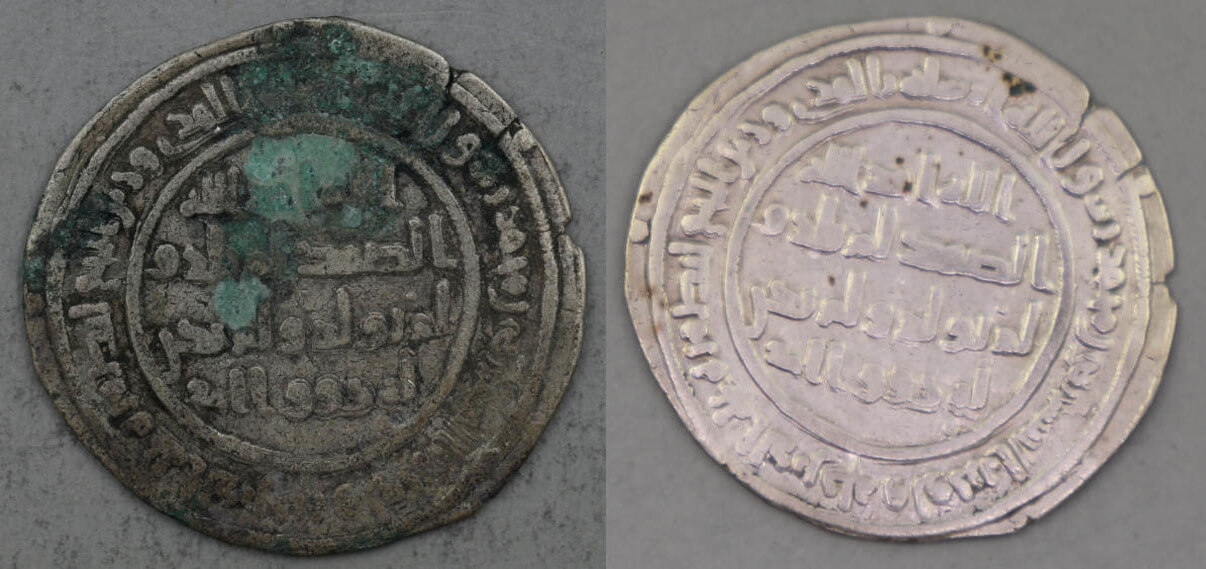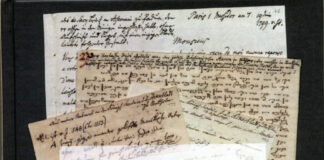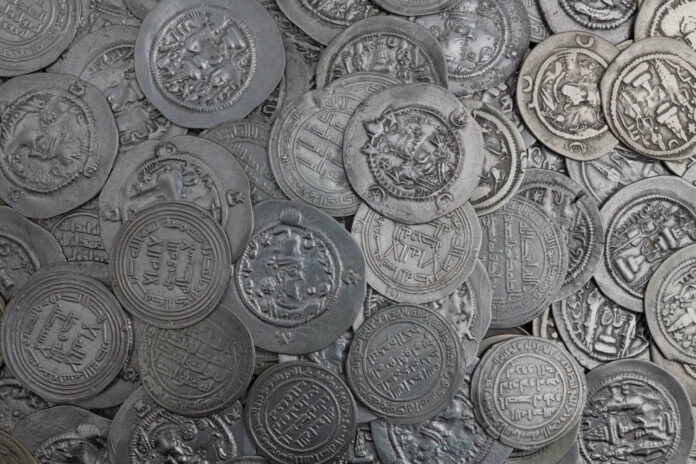
Please note, that this press release does not use the term “hoard” in its proper numismatic meaning!
Louvre Abu Dhabi unveils a rare treasure of Islamic silver coins – the Hoard of Jazira – the subject of a major two-year project at the museum. The museum installation includes a rare hoard, dating from the reign of King Shapur II (A.D. 309-379) until that of Abbasid Caliph Al Ma’mun (A.D. 813-833) and containing a large amount of medieval Islamic coins. This hoard of 2,861 silver coins manufactured in the Eurasian continent is supplemented by 67 additional single coins in gold or gold alloy produced in the regions of the Mediterranean basin and Eurasia during a period of about 1,000 years (from the 6th to the 16th century). The coins reveal regional and local history, signifying political changes, power struggles, and the changing value placed on precious metals throughout this period.
Leading on the curation of the Hoard of Jazira, Guilhem André, Chief Curator at Louvre Abu Dhabi, noted, “this display will showcase a global monetary history. It highlights the trade, cultural exchanges and political dynamics revealing an interconnected world economy between distant regions. It testifies to the birth of Islamic coinage and its evolution. The Sasanian drachmas, Umayyad dirhams, Abbasid silver coins, alongside the gold Byzantine solidus, the Genoese and Venetian gold coins, and more will prove how a simple coin can illustrate power relationships and rivalries among competing, growing empires well, as the emergence of major trade hubs.”
Theofanis Karafotias, Head of Preventive Conservation at Louvre Abu Dhabi, elaborated on the conservation process that had taken place before the public display: “The coins were not only conserved by the museum but also documented and digitized as well so that they could be studied in greater detail. We had to decide how to conserve each coin among the thousands – whether chemicals, an ultrasonic bath, or simple distilled water – considering which treatment would be the best, least intrusive way to reveal each coin’s face.”
This new presentation is dedicated to the financial centers that came into existence during the medieval period and their monetary systems. The diffusion of specific gold and silver coins and the trade of precious metals created the pre-conditions for the economy of the modern world, a practice which later had a considerable impact on the global economy. The new display sheds light on the transcontinental trade of gold and silver. The stylistic development of these coins works as an indicator of their evolving values in accordance with time and shifting geographies.
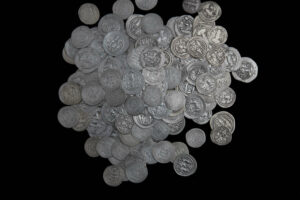
The Hoard of Jazira and the Rise of a Global Medieval Economy
The single showcase is dedicated to the “Hoard of Jazira”. This ensemble allows for a complete cycle of the birth of Islamic coinage. The hoard covers silver dirham, demi dirham, and drachma. It covers a geographic area of the Eurasian continent: from Spain until Central Asia.
Gold and silver exchange were fundamental pattern of the economical dynamics of the Medieval Period. The constant use of money and trade of precious metals was a major factor in the development of pre-modern financial system. They have specific consequences on the development of modern banking system and the raise of Atlantic routes.
This Hoard spreads over nearly 500 years, from the Sasanian to the Abbassid rulers. The earliest piece refers to the Sasanian king Shapur II (309-379) and the last one dates back to 820-821, during the reign of the 7th Abbasid Caliph Al Ma’mun (813-833).
The hoard of Jazira consists of 2,861 silver coins, and it includes: 434 Sasanian drachmas, 156 dirhams and half-Arab dirhams, 323 Umayyad dirhams, and 1948 silver coins of the Abbasid. It reflects the many adaptations and tax reforms due to political changes until the birth of a purely Islamic coin. The set contains a copy dating from the reign of Shapur II. An early dating piece that is not usually found in such treasure and which raises the interesting question of the running time of these currencies. The display evokes monetary treasures and finds a central place in the theme of metal exchange routes.
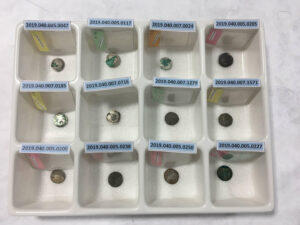
Inheritance and Adaptations of Existing Coinage
At the time when Arab expansions reached Iran and overcame the Sasanian army at Nihavand in the seventh century, the conquerors did not carry their own coinage. They had adopted the newly conquered lands’ monetary systems. In one system, Iran and Iraq used the Sasanian system of silver coins, featuring the monarch on one side and the Zoroastrian fire on the reverse. While in the other system, Syria, Jordan and Egypt, they used the Byzantine monetary system with gold coinage. Within the territories two financial structures existed that did not take part in common trade coins, which reflected a broader cultural and administrative division.
The used Sasanian drachms bears the name and bust of a bearded Sasanian emperor on the reverse. The obverse of the coin bore Pahlavi inscriptions and a representation of a Zoroastrian fire altar bordered by two priests.
By the end of seventh century, the adaptation of the Sasanian coins gradually paved the way towards a more drastic change in the coin composition. After many years of maintaining the existing fiscal systems, the Islamic governments started to take minting into their own hands. Adaptations began with mild additions such as the introduction of an Islamic inscription in praise of Allah on the existing coins. Arab governorates in Iran began minting a slight adaptation of the Sasanian drachm, announcing the Arab-Sasanian dirhams. As expected, these were minted in the regions of Iraq, Fars, Jibal, Kirman and Khurasan and by Persian die-engravers previously producing Sasanian coinage. They started bearing their names or the caliphs in Pahlavi and a religious quote.
The coin shown is identical to that on the prototype, but instead of Khusraw’s name there is a two-line transliteration into Pahlavi of the name of the governor and of his father. The other distinguishing feature is the legend basmala, “in the name of Allah”, written in Kufic, in the lower right-hand quarter.
This coin was minted about a year from the famous Battle of Karbala in late CE 680, where Husayn was killed, and the date is still marked by Shi’ites during Ashura (10 Muharram). ‘Ubaidullah bin Ziyad is an accursed figure in Shi’ite history.
In 685 AD, Bishapur mints added the shahada, while keeping the Sasanian drachms inherited figural iconography. The dirham of Hajaj bin Yousef introduced the shahada inscription on the obverse of the coin. On the reverse there is a mihrab and the Prophet’s short spear, accompanied by the words in Kufic, Amir al-muminin, meaning “Commander of the Believers”, and Khalifat- Allah, “Caliph of Allah”. The substitution of the prayer-niche and spear for the fire-altar without doubt reflects an attempt to create a purely Islamic iconography that is representative of the spiritual and temporal leadership of the caliph.
The reforms in coinage followed a process of broader administrative unification in the Islamic territories as Caliph Abd al-Malik overcame Mashriq’s Zubayrid governor, ending the internal conflict which that dissected the Islamic world since their accession regaining territory and starting this multilayered unification process, with Damascus as the capital of these far stretched territories where the earliest coins of precious metals struck in Syria began under Marwanid Damascus.
At the time of Muawiya, founder of the Umayyad dynasty, a centralized governance had been achieved. These reforms were part of the wider scheme of administrative reforms mentioned above by the early Marwanid caliphs, strengthening and centralizing the government structure. The scheme took years of implementation. Fiscal and linguistic reforms were used to reinforce the centralized government and its communication across its remote territories from a single center of sovereignty, Damascus.
The 77 H Dinar and Coinage Post Reform
This unification of identity definitely touched one of the main representations of sovereignty, coinage. The point of birth of a pure Islamic coin was under the Umayyad, notably Abd al Malik ibn Marwan, who unified coinage in an effort to unify Islamic lands under one government and economy. The start of the reforms was slow but finally ended with Abd Al Malik when in 77 H/697 AD he replaced the Umayyad dinar where the new coins were purely epigraphic replacing the inherited iconography with inscriptions in Arabic and for the first time from the Quran. A pure Islamic coinage is birthed, and in the next two years this new gold dinar is to be struck in all mints within the caliphate. Moreover, the silver coinage bearing longer inscriptions and the copper coins with only the shahada, followed in the following 2 years. The Islamic dirham became the most popular coin in the Near and Middle East and was used until the fall of the Umayyad in 132 H, nonetheless it left behind its own distinct legacy for later centuries.
This reform was accompanied by complementary policies establishing a comprehensive fiscal reform. The material reform was paired with a decree dictating its sole use on Umayyad lands, and went further to the melting of all previous circulating coins by the treasury. The precious metal epigraphic coinage was struck to a new weight standard, beginning a new page in the history of Islamic coinage. Notably, those coins are the earliest surviving inscriptions of the Quran, apart from the dome of the rock mosaics.
Centralising a Network of Mints
Based on records their existed 70 Umayyad dirham mints, 66 of them in the areas previously under the Sassanid monetary system, Iraq and Iran. On the other hand Damascus, Qairawan, Cordoba and an uncertain mint. The number of mints striking post reform coinage double of Arab-Sassanid striking mints.
As the coinage was unified from east to west on vast lands, keeping their uniformity from the Iberian Peninsula to central Asia, open door to the hypotheses of having central dies or even coins producing workshops in this network of mints.
By 749, under 10 Umayyad dirham mints continued fabrication: Al-Andalus (for Spain), Ifrlqiya (for North Africa), Dimashq (for Syria), al-Basra and Wasit (for southern ‘Iraq, plus al-Samlya, which opened only in the year 131), al-Jazira (for northern ‘Iraq), and al-Bab (for the Caucasus area). Wasit being a very productive mint at the time of the Ummayads. Notably dirhams were stopped being struck in Mashriq mints of the Mashriq, however resuming by the Abbasid supporters.
Abbasids Governors of Tabaristan
While the coinage reform of ‘Abd al-Malik which took place between 696-9, of an ending of figural depictions, it took some time to be implemented in certain areas in Iran. Sasanian and quasi-Sasanian types, based on political situation, persisted for several generations in outlying areas. Apart from addition of new names, it was not a disruption or deviation in the mints of this area. Abbasid governors of Tabaristan struck Sassanid dirhams until 794) A.D. Typical specimens can be found in this batch.
Umayyads of Spain
The coinage of Spain under the Umayyads, the Arabs brought in a new form of coinage to the Iberian Peninsula, leading to the hypothesis that they brought mint workers with them. During the Umayyad period in Spain, the caliph’s names and title appeared on the reverse of the coins. The weights of those coins were not accurate in comparison the eastern Umayyad dinars. From 1010 AD, a period of decline, local sovereigns started sticking their own coinage. They took as prototype the Umayyad dinar. The form of the Latin solidi was continued, the reverse has “Mohammed Rasulallah” and replaces the Latin inscription on the obverse with mint name and striking date, as did the eastern Damascus mints.

Abbasid
Reforms continued in later periods with the Abbasid, notably with Caliph Al Mamun who assigned many reforms and issued a new coin. In this period coins began to bear the ruler’s name and kunya or titles and often those of heirs to the caliphate. During this period, we can see additions of double circular inscriptions containing more religious text and the introduction of the names of subordinates, court figures and governors.
The development of various governorships in the eighth century is reflected in the contemporary coinage. For instance, a series of dinars by Harun al-Rashid present in this hoard, offer a wide range of kunia names and isolated letters that belonged to the contemporary administrative apparatus. Such coins shed more light on the history of that huge province in the early Islamic period.
Idrisid and Aghlabid Coins
This hoard holds coins from dynasties from Ifriqyia that were a continuation to the Abbasid example.
Aghlabid style coins from the mints Ifriqya, are circular in shaoe in simple Kufic script encircled by another inscription in continuation of the first period Abbasid coin composition. However, it includes prince’s names and the Aghlabid motto “galab” (victory) and continues to be the case until the arrival of the Fatimids. Aghlabid coins were used around the Mediterranean basin.
Idrisids of Fez, with conformed in weight and followed Abbasid coinage. The composition sees the addition of the Shiite blessing, the name of Ali ibn Abi Talib, the Idrisids ancestor and a partisan statement saying from the 17th sura: “truth has come and falsehood perished: for falsehood is bound to perish”.
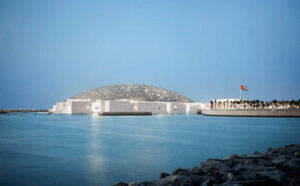
The Louvre Abu Dhabi
Created by an exceptional agreement between the governments of Abu Dhabi and France, Louvre Abu Dhabi was designed by Jean Nouvel and opened on Saadiyat Island in November 2017. The museum is inspired by traditional Islamic architecture and its monumental dome creates a rain of light effect and a unique social space that brings people together.
Louvre Abu Dhabi celebrates the universal creativity of mankind and invites audiences to see humanity in a new light. Through its innovative curatorial approach, the museum focuses on building understanding across cultures: through stories of human creativity that transcend civilizations, geographies and times.
The museum’s growing collection is unparalleled in the region and spans thousands of years of human history, including prehistoric tools, artefacts, religious texts, iconic paintings and contemporary artworks. The permanent collection is supplemented by rotating loans from 13 French partner institutions, regional and international museums.
Louvre Abu Dhabi is a testing ground for new ideas in a globalized world and champions new generations of cultural leaders. Its international exhibitions, programming and Children’s Museum are inclusive platforms that connect communities and offer enjoyment for all.
For further information about the museum, visit the website of the Louvre Abu Dhabi.
In 2020 an exciting numismatic exhibition was opened in Abu Dhabi.
You can find more information about Islamic coinage in this CoinsWeekly article: Drachm, Dirham, Crown and Pound.
We also presented the first Islamic gold coin in a detailled article.



